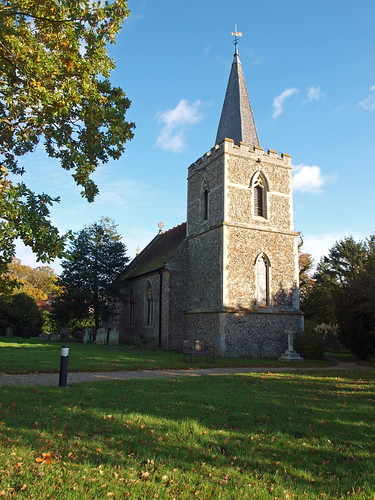It took me ages to find St Andrew, tucked away off the road and hidden by trees, and I only found it by reversing my route. It is so isolated that I was fully expecting externals only but to my delight it was open. My delight was not due to an earth shattering interior, it is plain to the extreme, but merely that its openness restores some of my faith in church custodians.
In truth St Andrew is nothing to write home about (or probably blog about) but I liked both its simplicity and its situation and, as the last visit of the day, it was a welcome treat and one of the nicest churches of the day.
ST ANDREW. So thoroughly restored in 1869 by C. J. Moxon that nothing of interest remains outside. Inside behind the pulpit three odd niches, the taller central one pointed, the Norman, square, of Purbeck marble with zigzag decoration and incised concentric circles in the spandrels on the top.
ST ANDREW. So thoroughly restored in 1869 by C. J. Moxon that nothing of interest remains outside. Inside behind the pulpit three odd niches, the taller central one pointed, the Norman, square, of Purbeck marble with zigzag decoration and incised concentric circles in the spandrels on the top.
WHITE COLNE. Its two best possessions are a pulpit and a chair, treasured in a church whose walls are probably 800 years old. The chair is 16th century, rich with flowers, a shield-of-arms, and a lamb with a flag. The pulpit is a splendid piece of Jacobean work, finely ornamented with figures in three panels. We see St James the Great with a staff and a gourd, St Augustine of Hippo with a mitre and crozier, and Charity carrying a babe who holds an orb in one hand and blesses us with the other. Between the panels are pilasters enriched with jewel ornament, and among the decorations of the cornice are two human masks. The church has Roman bricks at its corners, and a high and narrow chancel arch 600 years old. Its companions in the churchyard are several handsome oaks. Here stands Fox and Pheasant Farm, built in Cromwell’s time, with a fox and a pheasant on one of its fireplaces. It has sent treasures of the soil to Colchester Museum, urns and other fragments from a Celtic burial ground discovered in 1924.
Simon K -
I had come this way a few days earlier. Deceived by a brief burst of sunshine, I had set off from Pebmarsh church for dear old Chappel and Wakes Colne station a few miles further south, and decided to take in White Colne on the way.
Well, I am ever one to exaggerate the narrowness, hilliness and windiness of lanes of north Essex, not to mention their surface water, but the lanes (if you will refer to your OS map) in the area bounded by Halstead, Pebmarsh, Bures and Chappel are something else again. Fortunately, I didn't meet a single car between leaving the last church and reaching the next one, but it did start to rain again, really heavily, and I was pretty soon the wettest I'd been.
I arrived at All Saints and found it locked with a keyholder notice.
If I'd told you then that this was a solidly built but over-restored little church with a west tower surmounted by a broach spire then I'd probably have been right, but I wouldn't have been able to swear to it. Visibility was poor, I was soaked and the rain was intense, and so I was in no mood to go looking for a keyholder who might or might not be in.
Besides, the notice said that the church was Open every Tuesday and Wednesday from 9am to 3pm. I'll come back on Tuesday, I thought! A train left C&WC in 15 minutes, and I planned to be on it.
I came back three days later in the last sunshine of a fine but fading afternoon. The little building looked well across the fields, gazing across the valley with the smoke of Chappel and Wakes Colne below. I pushed my bike enthusiastically up to the door.
Locked. I'd say I couldn't quite believe it, but see Kelvedon. I rang the lady.
"But it can't be locked!" she remonstrated. "He opens it at eight, and then locks it again on his way home at four!" I told her that, nonetheless, it was locked. "Oh for goodness sake," she said, "I'll be there in a minute". But she was very nice, and it turned out that her exasperation was with the failed unlocker and not with me.
This is a prettier church inside than out, with the definitive feel of
a small Victorian rural church interior. It has been recently
redecorated, so it also benefits from a cool Anglican freshness. The
curiosity is the pulpit, which appears to be 17th century, but has
contemporary Flemish panels attached to it, and is thus most unusual.
I hope it does not sound harsh if I say that I liked this church more
than it probably deserved, but I did like it. I sat for a while in the
absolute silence until it was broken by a sad blackbird in the bushes
outside, and then headed for Chappel and Wakes Colne Station for the
train home.
Flickr Set.

I found it as Simon Knott did.
ReplyDelete